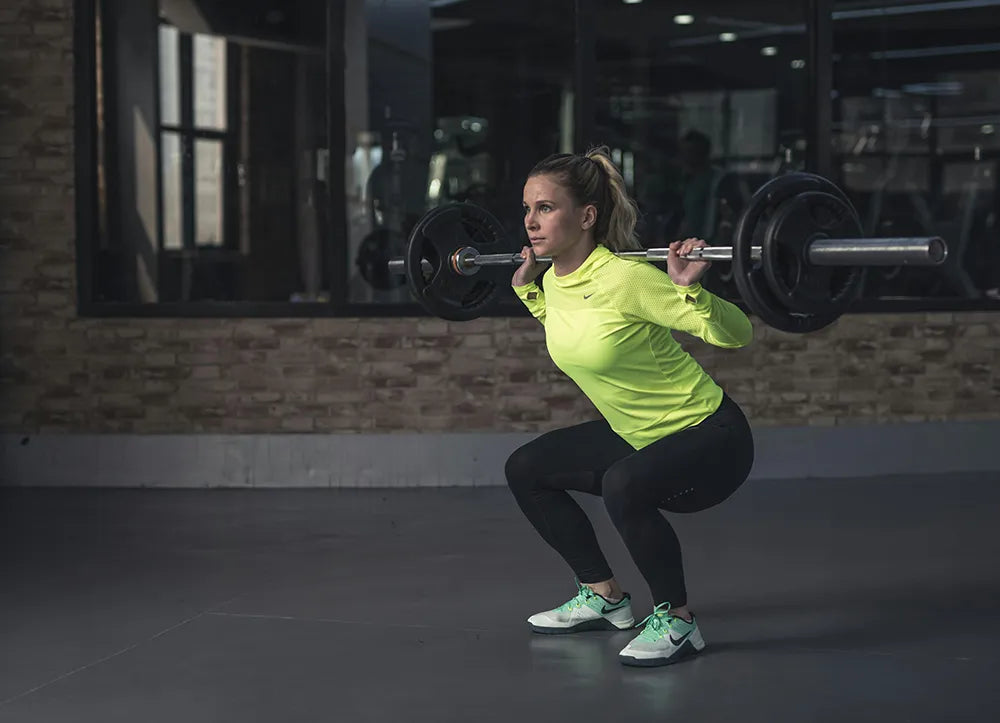Entraînement musculaire pour les femmes : la science et les faits


Il existe un mythe selon lequel la musculation est réservée aux hommes. Vous connaissez celui -là : on dit aux femmes que soulever des poids les transformera en mastodonte du jour au lendemain.
Attention, spoiler : ce ne sera pas le cas. La musculation est de plus en plus reconnue comme un outil puissant pour les femmes, et il est grand temps de mettre en lumière son importance.
La musculation pour les femmes ne se limite pas à la prise de masse musculaire ; elle permet de développer un corps fort et sain, capable d'affronter les défis de la vie. De l'amélioration de la densité osseuse à l'amélioration de la santé mentale , les bienfaits sont nombreux .
Alors pourquoi ne pas prendre quelques haltères et plonger dans le monde des poids ?
Cet article démystifiera les mythes, soulignera les avantages et fournira un guide pratique aux femmes prêtes à adopter la musculation.
Démystifier les mythes sur les femmes et la musculation
Abordons le premier mythe : la musculation rend les femmes plus volumineuses. Cette idée fausse provient peut-être de l'image des culturistes de compétition, mais voici la vérité.
Les femmes peuvent-elles soulever des poids lourds ?
Les femmes ont des niveaux de testostérone nettement inférieurs à ceux des hommes, ce qui signifie qu'elles ne développent pas de masse musculaire aussi facilement .
Des études scientifiques montrent que même si les femmes peuvent sans aucun doute gagner en force et en muscle, l'augmentation de la taille est généralement beaucoup moins prononcée. [1] Au lieu de devenir volumineuses, les femmes qui soulèvent des poids développent souvent des muscles toniques qui donnent une apparence plus mince.
Pensez-y de cette façon : si vous craignez de ressembler à un secondeur, soyez assuré que la plupart des femmes ne sont pas construites de cette façon , même avec un entraînement de force dédié.
Une autre inquiétude courante est que la musculation est dangereuse pour les femmes. Ce mythe naît souvent de la peur des blessures ou d'une mauvaise technique.
S'il est vrai qu'une mauvaise technique peut entraîner des blessures, un accompagnement et une formation sont essentiels. Apprendre les bonnes techniques peut réduire considérablement les risques.
En commençant avec des poids plus légers et en se concentrant sur la forme , les femmes peuvent intégrer en toute sécurité la musculation dans leurs routines . De plus, de nombreuses salles de sport proposent des cours spécialement conçus pour les débutants, offrant un environnement propice à l’apprentissage des ficelles du métier .
Cardio vs. musculation
En matière de fitness, le cardio est souvent au cœur de l'attention. Mais ne négligeons pas l'importance de la musculation, notamment en ce qui concerne l'EPOC (consommation excessive d'oxygène après l'exercice).
En termes simples, l’EPOC fait référence à la quantité d’oxygène que le corps utilise après l’exercice pour se rétablir aux niveaux d’avant l’exercice.
Ce processus brûle des calories et peut durer des heures, même après la fin de l'entraînement . Le cardio contribue à l'EPOC, mais il a été démontré que la musculation a un effet plus important .
C’est vrai : soulever des poids peut maintenir votre métabolisme actif longtemps après avoir quitté la salle de sport.
Alors, qu'est-ce qu'il faut retenir ? Le cardio et la musculation sont tous deux essentiels à une routine de remise en forme complète.
Cependant, si vous cherchez à stimuler votre métabolisme et à continuer à brûler des calories après l'entraînement , ajouter des poids au mélange est un choix judicieux.
Mais examinons les chiffres pour bien comprendre l'impact des différents types d'exercice sur la dépense calorique et l'EPOC. Imaginez : une séance de musculation classique peut brûler environ 600 calories, mais la magie ne s'arrête pas là.
Grâce à EPOC, vous pourriez brûler 80 calories supplémentaires après l'entraînement. C'est comme obtenir 13 % de bonus sur votre investissement calorique !
Maintenant, comparons cela à d’autres formes d’exercice populaires :
L'entraînement fractionné à haute intensité (HIIT) est un véritable concentré de calories. Une séance de 30 minutes peut brûler environ 500 calories, tandis que l'EPOC ajoute 85 calories supplémentaires . Soit un gain impressionnant de 17 % !
Les activités cardio traditionnelles comme la course à pied ou le vélo , bien qu'efficaces, ne rivalisent pas avec la musculation ou le HIIT en termes d'EPOC. Une course de 30 minutes peut brûler 300 calories, auxquelles s'ajoutent 26 calories supplémentaires provenant de l'EPOC , soit une augmentation d'environ 8 %.
La natation, souvent saluée pour son entraînement complet du corps, brûle environ 350 calories en 40 minutes. L'effet EPOC ajoute 30 calories supplémentaires, soit un bonus de 9 %.
Le yoga et le Pilates offrent toujours des avantages pour ceux qui privilégient les exercices à faible impact, bien qu'avec un effet EPOC plus faible . Une séance de yoga d'une heure peut brûler 150 calories avec un léger gain EPOC de 2 à 5 %.
Le point essentiel à retenir ici est que, même si toutes les formes d’exercice sont bénéfiques, certaines vous permettent de brûler plus de calories pour votre argent, en particulier en ce qui concerne cet effet de postcombustion tant convoité.
L’intégration d’un mélange de musculation, de HIIT et de cardio traditionnel dans votre routine peut aider à maximiser la combustion des calories immédiate et à long terme.
Examinons l'impact des différentes modalités d'exercice sur l'EPOC et la dépense calorique globale. Les chiffres parlent d'eux-mêmes et montrent pourquoi l'intégration de la musculation à votre programme de remise en forme peut changer la donne.

Avantages de la musculation pour les femmes
Passons maintenant aux bons côtés : les avantages. Tout d'abord, les avantages physiques.
La musculation peut améliorer le tonus et la force musculaires, des aspects cruciaux avec l'âge. Ce n'est pas seulement une question d'esthétique ; développer sa force facilite les tâches quotidiennes, rendant la vie plus facile et plus agréable.
De plus, l'haltérophilie améliore la densité osseuse, réduisant ainsi le risque d'ostéoporose. Avec l'âge, le maintien de la santé osseuse devient de plus en plus important. [2]
Pourquoi les femmes devraient-elles soulever des poids ?
Soulever des poids peut vous aider à garder vos os forts et en bonne santé, vous préparant ainsi à une vie plus active plus tard.
Et puis, il y a le boost métabolique. Qui n'a pas envie de manger une part de pizza supplémentaire sans culpabilité ?
L’entraînement en force accélère votre métabolisme, vous permettant de gérer votre poids plus efficacement.
Sur le plan mental et émotionnel , les bénéfices sont tout aussi impressionnants . Les femmes ressentent souvent un regain de confiance et d'estime de soi après avoir pratiqué la musculation.
Terminer un entraînement difficile peut vous donner un sentiment d’accomplissement difficile à reproduire ailleurs.
De plus, soulever des poids peut contribuer à réduire l'anxiété et la dépression. Les endorphines libérées pendant l'exercice agissent comme des stimulants naturels de l'humeur.
De plus, une bonne séance d’entraînement peut conduire à un meilleur sommeil et à une meilleure gestion du stress.
N'oublions pas non plus les bienfaits à long terme pour la santé . Un entraînement musculaire régulier peut réduire le risque de maladies chroniques, améliorer la posture et optimiser les capacités fonctionnelles globales.
Cela signifie une meilleure qualité de vie, permettant aux femmes de conserver leur indépendance à mesure qu’elles vieillissent.
Comment débuter l'haltérophilie en tant que femme
Alors, comment se lancer dans ce voyage d’haltérophilie ?
Tout d’abord, il est essentiel de choisir le bon équipement.
Les haltères, les barres et les bandes de résistance sont d'excellents choix pour les débutants. De nombreux produits sont spécialement conçus pour les femmes, privilégiant le confort et la facilité d'utilisation.
Lorsqu'il s'agit de créer un programme d'entraînement, l'équilibre est essentiel . Il est crucial d'intégrer la musculation et le cardio à votre routine. [2]
Un plan bien conçu peut aider à prévenir l’épuisement professionnel et à maintenir l’intérêt.
Un exemple de programme d’entraînement hebdomadaire pour les femmes :
- Lundi : Entraînement musculaire du haut du corps
- Mardi : Cardio (comme la course à pied ou le vélo)
- Mercredi : Entraînement musculaire du bas du corps
- Jeudi : Repos ou activité légère
- Vendredi : entraînement complet du corps
- Samedi : Cardio
- Dimanche : Repos
Ce plan maintient vos muscles engagés tout en permettant un temps de récupération, ce qui est essentiel à la croissance.
Programme d'entraînement pour débutantes pour femmes
Prêt à soulever des poids ? Découvrons ensemble un entraînement avec haltères pour débutants.
Commencez avec des poids gérables pour assurer une forme appropriée.
Voici une routine simple :
Squats : Debout, les pieds écartés à la largeur des épaules, des haltères à vos côtés. Abaissez votre corps comme si vous étiez assis sur une chaise, en gardant la poitrine bombée.
Visez 10 à 15 répétitions.
Développé couché avec haltères : Allongez-vous sur un banc, un haltère dans chaque main. Poussez les poids au-dessus de votre poitrine, puis redescendez-les.
Faites 10 à 12 répétitions.
Rowing penché : Penchez-vous légèrement au niveau des hanches, un haltère dans chaque main. Tirez les poids vers vos hanches en serrant les omoplates.
Effectuez 10 à 12 répétitions.
Soulevés de terre : pieds écartés à la largeur des hanches, tenez les haltères devant vos cuisses. Abaissez les poids en gardant le dos droit, puis revenez en position debout.
Visez 10 à 15 répétitions.
Commencer par ces exercices vous donnera une base solide. À mesure que vous progressez, pensez à augmenter les poids ou à ajouter des mouvements plus complexes.
Culturisme féminin : passer à la vitesse supérieure en musculation
Pour ceux qui sont prêts à améliorer leur jeu , la transition du niveau débutant au niveau avancé peut être passionnante .
Les signes indiquant que vous êtes prêt à augmenter l’intensité incluent le fait de vous sentir à l’aise avec vos poids actuels et de ne pas ressentir de fatigue musculaire à la fin de vos séances d’entraînement.
L’intégration de mouvements composés , comme les squats et les soulevés de terre , peut encore améliorer votre routine d’entraînement en force.
Ces exercices sollicitent plusieurs groupes musculaires, vous offrant ainsi un meilleur rapport qualité-prix.
Si vous êtes sérieux au sujet de la musculation, pensez à investir dans des équipements comme un power rack ou un squat rack pour votre salle de sport à domicile avec un banc de musculation réglable afin de pouvoir effectuer pratiquement tous les exercices.
Avoir les bons outils à votre disposition peut faire toute la différence dans votre formation.
Posséder un support à squat ouvre non seulement un monde d'exercices , mais fournit également un environnement sûr pour soulever des poids plus lourds en l'équipant de bras de repérage .
C'est comme avoir une salle de sport dans votre garage, sans les inconnus en sueur.
Développer sa force demande du temps et du dévouement, mais les récompenses en valent la peine.
Réflexions finales
La musculation pour les femmes est un parcours enrichissant aux nombreux bienfaits. Nous avons démystifié les mythes qui freinent de nombreuses personnes, mis en lumière ses avantages physiques et mentaux et présenté des étapes pratiques pour se lancer.
En vous lançant dans l'univers des poids, n'oubliez pas que chaque répétition est un pas vers une vie plus forte et plus saine. Alors, pourquoi ne pas essayer ce programme d'entraînement pour débutants ?
Partagez vos progrès avec vos amis ou sur les réseaux sociaux ; vous pourriez inspirer quelqu'un d'autre à soulever aussi !
La musculation n'est pas réservée aux accros de la salle de sport ; elle est accessible à tous. Prenez des poids et montrez au monde de quoi vous êtes capable .
Référence
- Staron RS, Karapondo DL, Kraemer WJ, Fry AC, Gordon SE, Falkel JE, Hagerman FC, Hikida RS. Adaptations des muscles squelettiques au cours de la phase initiale d' un entraînement intensif en résistance chez les hommes et les femmes. J Appl Physiol (1985). Mars 1994 ; 76(3) : 1247-55. doi : 10.1152/jappl.1994.76.3.1247. PMID : 8005869.
- Kraemer WJ, Mazzetti SA, Nindl BC, Gotshalk LA, Volek JS, Bush JA, Marx JO, Dohi K, Gómez AL, Miles M, Fleck SJ, Newton RU, Häkkinen K. Effet de l'entraînement en résistance sur la force/puissance et les performances professionnelles des femmes. Med Sci Sports Exerc. Juin 2001 ; 33(6) : 1011-25. doi : 10.1097/00005768-200106000-00022. PMID : 11404668.


